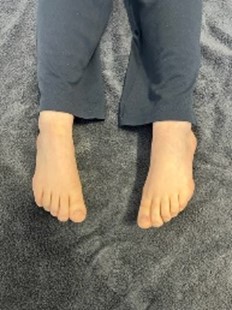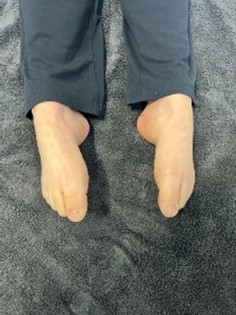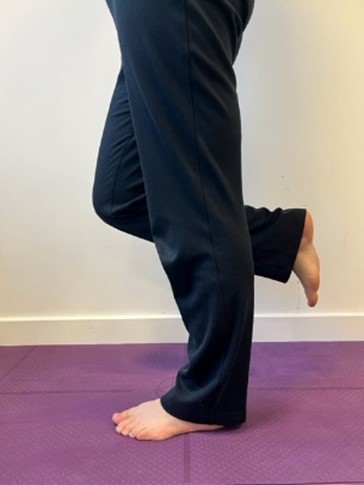On this page
Ankle pain is very common and is usually caused by an injury often after “rolling” or inverting your ankle. However, you should seek medical attention immediately if you have any of the following symptoms following an injury to your ankle:
- Your ankle is misshapen.
- You cannot move the injured ankle.
- Your ankle gives way when you try to use it.
- You have severe pain and cannot put weight through the injured ankle.
What can I do to help my symptoms?
Your ankle problem should improve within twelve weeks if you follow the correct advice. If your ankle problem has not improved within twelve weeks, the pain gets worse, or your calf becomes hot, swollen and tender: you should seek medical attention. Following the advice below may help to improve your recovery:
Pain relief
Simple analgesia such as Paracetamol and an anti-inflammatory such as Ibuprofen can be very effective for the treatment of ankle pain. You can obtain advice regarding medication from your local pharmacist or GP but remember to read the packet; and do not take over the recommended dosage.
Ice packs
Ice can be very effective in reducing the pain that results from a swollen ankle.
Do not use ice if you have circulatory problems, such as Raynaud’s disease, history of cold induced hypertension, peripheral vascular disease, allergy to cold (urticaria, joint pain) or sickle cell anaemia. If your skin is usually numb over the injured area, please speak to your physiotherapist or GP before using a cold pack / ice.
Ice must be used correctly otherwise ice burns can occur. Please see the instructions below:
- Start by wetting a cloth under a cold tap and then wring the cloth out until it is just damp.
- Place the damp cloth over affected area and then place either a plastic bag of crushed ice or a packet of frozen peas on top of the cloth. (The ice should be in small pieces in order to mould better to the area and help prevent ice burns).
- Leave the ice pack and cloth in place for approximately 10-15 minutes and repeat 3 to 4 times a day.
It is normal for your skin to go slightly red or pink. Remove the ice if extreme redness/pain, blistering or an increase in swelling occurs. If this does occur, please call NHS Direct for further advice.
Rest
Try to rest the painful ankle and avoid standing or walking for long periods of time in the first 72 hours. It is important to continue to try and walk short distances. This may be painful but it will help any injured tissues heal quicker. Try to walk without a limp using a normal walking action even if you need to use a stick or crutches.
It is also important to avoid long periods of time of not moving the ankle as this can prolong any swelling and stiffen the ankle. Normal healing is encouraged through gentle movements. It is important to move your ankle gently for about 30 seconds every hour. Please refer to the gentle ankle exercises described later in this section.
After the initial few days, you should increase your activities returning to all normal roles as your pain allows.
Elevation
If your ankle is swollen, try to keep the ankle raised as much as possible when at rest. This will help to manage any swelling.
Compression
Using a tubigrip or another form of compression bandage for the first 72 hours can help to reduce ankle swelling. This should be snug but not so tight that it restricts blood flow. You should remove the bandage before you go to sleep and to do the gentle ankle exercises.
Exercises
These exercises have been designed by a physiotherapist to prevent your foot and ankle from stiffening up and your ankle and foot muscles from weakening. If performed correctly and regularly, they will aid your recovery. They will help to prevent a recurrence of the ankle problems.
When doing the exercises, it is normal to feel discomfort. The pain is caused by moving sensitive tissues and will not cause any ‘damage’.
Do not continue the exercises if they significantly increase your pain or swelling. If this does occur, please see your GP / Physiotherapist for further advice.


Exercise 1: Dorsiflexion / plantar flexion
Sitting or lying, bend and straighten your ankle so your toes point towards and then away from you.
Repeat 10 times every hour.


Exercise 2: Inversion / Eversion
Sitting or lying, turn your foot inwards and outwards.
Repeat 10 times every hour.
Exercise 3ab / 3b / 3c: Proprioception

You may also be able to progress yourself onto some balance exercises to help strengthen your ankle and improve your stability. For each of these exercises, please ensure you are stood next to something that you can hold onto, should you need to.
3a. Stand on 1 leg (on your injured side) and hold for up to 30 seconds.
3b. Stand on 1 leg (on your injured side) and close your eyes. Hold for up to 30 seconds.
3c. Walk around the edge of a rug or doormat, trying to balance on the edge. Repeat 5 circuits clockwise and then 5 anticlockwise. When this gets easy you can try doing the same thing but walking backwards.
Repeat exercises 3-4 times a day.
What about sports?
It is not advisable to return to sport until your swelling has settled and you have regained your full (or almost full) ankle movement and strength. You should also be able to take your full weight through your leg without limping. If you return to sport prior to this you are at increased risk of reinjuring your ankle.
What about work?
Maintaining all normal activities including work improves your chance of recovery by keeping you moving. This helps you keep your ‘work fitness’ and prevents your ankle getting weak, which can prolong your pain.
Remember: You do not have to be pain free to return to or remain at work.
It may be necessary to do temporary lighter or modified duties. This should be discussed with your line manager initially. If further clarification is needed your Occupational Health advisor can identify more specific role modifications.
What should I do if I am still experiencing problems?
If you are unable to agree on restricted roles with you manager or you are still having problems (despite following this advice): your Occupational Health team can help. The Occupational Health team can advise you on how to bridge the gap to help you return to normal activities. You can also gain access to the Occupational Health physiotherapy team by:
Self-referral
The Occupational Health Physiotherapy team can assist in the management of musculoskeletal problems that affect your ability to work. Staff are able to self-refer to physiotherapy via the trusts Occupational health internet page.
Management referral
If you feel your symptoms are having a significant effect on your ability to carry out your role, discuss this with your manager and request a referral to the Occupational Health Service.
Download and print the ankle pain information